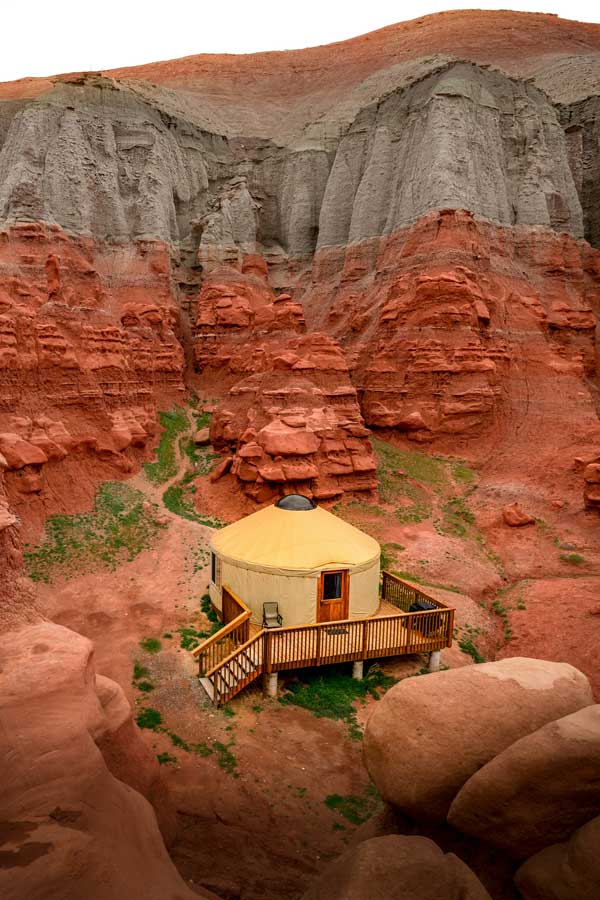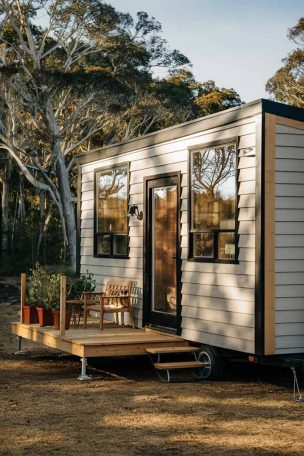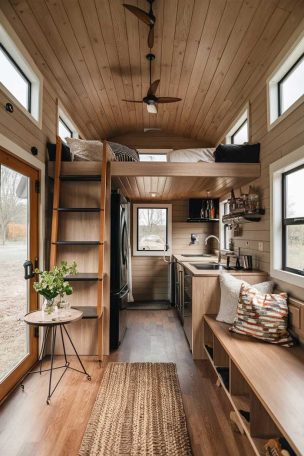The tiny house movement has been gaining momentum for years, captivating the hearts of minimalists, environmentalists, and those seeking financial freedom. These pint-sized dwellings, typically under 400 square feet, offer a unique blend of simplicity and sustainability. But as their popularity soars, so do the questions about their legality.
Let’s face it: navigating the legal landscape of tiny homes can be as tricky as maneuvering one down a narrow country road. While the idea of downsizing to a cozy, efficient space might seem straightforward, the reality is far more complex. Zoning laws, building codes, and local regulations create a patchwork of rules that vary dramatically from one place to another.
So, where are tiny homes legal? Buckle up because we’re about to embark on a cross-country tour of tiny home legislation, uncovering the friendly states, the not-so-friendly ones, and everything in between.
State-Level Legality
| State | Tiny House Legality | Notes |
|---|---|---|
| Alaska | Restricted | Effectively illegal or highly restricted |
| Arizona | Legal | |
| California | Legal | Most tiny home-friendly state; many cities allow tiny homes on foundations or wheels |
| Colorado | Legal | Hosts tiny home festivals; regulations vary locally |
| Florida | Legal | Warm climate appeals to tiny home enthusiasts; minimum size requirements vary by county |
| Georgia | Legal | |
| Idaho | Legal | |
| Indiana | Legal | |
| Iowa | Restricted | Effectively illegal or highly restricted |
| Kansas | Legal | |
| Louisiana | Restricted | Effectively illegal or highly restricted |
| Maine | Legal | |
| Massachusetts | Legal | |
| Michigan | Legal | |
| Minnesota | Legal | |
| Nebraska | Legal | |
| New Hampshire | Legal | |
| New Jersey | Restricted | Effectively illegal or highly restricted |
| New Mexico | Legal | |
| New York | Restricted | Effectively illegal or highly restricted |
| North Carolina | Legal | Abundance of builders and materials; popular communities around Asheville and Lexington |
| North Dakota | Restricted | Effectively illegal or highly restricted |
| Oregon | Legal | Tiny home-friendly legislation; some cities actively encourage tiny home living |
| Pennsylvania | Legal | |
| South Carolina | Legal | |
| South Dakota | Legal | |
| Tennessee | Legal | |
| Texas | Legal | Thriving communities in major cities; Spur is the first tiny home-friendly town in the U.S. |
| Utah | Legal | |
| Vermont | Legal | |
| Washington | Legal | |
| West Virginia | Restricted | Effectively illegal or highly restricted |
| Wisconsin | Restricted | Effectively illegal or highly restricted |
| Wyoming | Legal |
Note: For states not specifically mentioned in the research as legal or restricted, their status is not included in this table. Additionally, even in states where tiny homes are generally legal, local zoning ordinances and building codes may vary significantly, potentially restricting tiny homes in certain areas.
Tiny Home-Friendly States
When it comes to tiny home living, not all states are created equal. Some have rolled out the welcome mat, while others have firmly shut the door. Let’s start with the good news and explore the states where tiny homes are finding their place in the sun.
California: The Golden State of Tiny Living
It’s no surprise that California, known for its progressive stance on many issues, leads the pack in tiny home friendliness. The state’s commitment to addressing climate change aligns perfectly with the sustainable ethos of tiny living.
In California, you’ll find a multitude of cities and municipalities that allow tiny homes, whether they’re on wheels or a permanent foundation. From the bustling Bay Area to the sun-soaked shores of Southern California, tiny home communities are popping up like wildflowers after a spring rain.
What makes California stand out is its approach to Accessory Dwelling Units (ADUs). Recent legislation has made it easier than ever to add a tiny home to an existing property, opening up new possibilities for multi-generational living and affordable housing solutions.
Oregon: Pioneering Tiny Home Legislation
Not to be outdone by its southern neighbor, Oregon has carved out its own niche in the tiny home world. The state has embraced tiny home-friendly legislation, with some cities actively encouraging this alternative form of housing.
Portland, in particular, has become a hub for tiny home enthusiasts. The city’s progressive zoning laws allow for tiny homes on wheels in backyards, and there’s even a thriving tiny home village just outside the city limits. It’s a testament to Oregon’s commitment to innovative housing solutions and sustainable living.
Texas: Going Big on Tiny
Everything’s bigger in Texas – including the opportunities for tiny home living. The Lone Star State has thrown its cowboy hat into the ring, with major cities like Austin, Houston, and Fort Worth boasting thriving tiny home communities.
But the real jewel in Texas’s tiny home crown is the town of Spur. This small community made headlines when it declared itself the first tiny house-friendly town in America. With relaxed building codes and a welcoming attitude, Spur has become a beacon for tiny home enthusiasts looking to put down roots.
Colorado: Tiny Homes in the Rockies
Colorado’s stunning landscapes and outdoor-loving culture make it a natural fit for the tiny home lifestyle. The state celebrates tiny living with annual festivals, bringing together enthusiasts, builders, and curious onlookers.
While regulations vary from one locality to another, Colorado offers diverse environments for tiny home communities. Whether you dream of a mountain retreat or a high desert haven, there’s likely a spot for your tiny home in the Centennial State.
North Carolina: East Coast Tiny Home Haven
For those looking to go tiny on the East Coast, North Carolina is hard to beat. The state boasts an abundance of tiny home builders and materials, making it easier to turn your downsizing dreams into reality.
From the misty Blue Ridge Mountains to the sun-drenched Outer Banks, North Carolina offers scenic locations that are perfect for tiny living. Popular tiny home communities have sprung up around Asheville and Lexington, catering to those who want to embrace the tiny lifestyle without sacrificing a sense of community.
States with Restrictions
While many states are opening their arms to tiny homes, others are taking a more cautious – or downright hostile – approach. It’s crucial to be aware of these less tiny-friendly locales if you’re considering making the move to a smaller footprint.
States like Alaska, Iowa, Louisiana, North Dakota, New Jersey, New York, West Virginia, and Wisconsin have effectively made tiny homes illegal or imposed such strict regulations that they’re practically impossible to build or live in legally.
In these states, you might encounter minimum square footage requirements that far exceed tiny home dimensions or zoning laws that simply don’t account for this type of dwelling. It’s not that these states are anti-tiny homes per se, but rather that their existing regulations haven’t caught up with this housing trend.
Even in states that are generally tiny home-friendly, you’ll find cities and counties with their own restrictive regulations. This patchwork of rules underscores the importance of thorough research before committing to a tiny home location.
Zoning and Building Code Considerations
Now that we’ve got a bird’s eye view of state-level legality, let’s zoom in on the nitty-gritty details of zoning and building codes. These local regulations often make or break the feasibility of tiny home living in a particular area.
Foundation-Based Tiny Homes
Tiny homes built on permanent foundations are generally treated much like traditional single-family homes. This means they’re subject to the same local building codes and zoning regulations as their larger counterparts.
The good news? This classification often makes it easier to get approval for a foundation-based tiny home. The bad news? You might run into minimum size requirements that push the boundaries of what’s considered “tiny.” Some areas have minimum square footage requirements that exceed the typical tiny home size, effectively pricing them out of the market.
Additionally, foundation-based tiny homes need to meet all local building codes. This can include requirements for things like ceiling height, staircase width, and emergency exits. While these regulations are designed with safety in mind, they can sometimes clash with the creative, space-saving designs that make tiny homes so appealing.
Tiny Homes on Wheels
Tiny homes on wheels (THOWs) present a unique set of challenges when it comes to zoning and building codes. These mobile dwellings often fall into a grey area between RVs and traditional homes.
In many areas, THOWs are classified as recreational vehicles. This classification can be both a blessing and a curse. On the one hand, it might make it easier to park your tiny home in places like RV parks or campgrounds. On the other hand, it can limit your ability to live in your tiny home full-time in residential areas.
Some localities have specific rules about how long an RV can be parked in one spot, or whether it can be used as a primary residence. These regulations can make it challenging for THOW owners to put down roots in a community.
Specific Tiny Home Regulations
As the tiny home movement gains traction, some forward-thinking areas are developing specific regulations to address this unique form of housing. One of the most significant developments in this arena is Appendix Q of the International Residential Code.
Appendix Q provides building code standards specifically for tiny homes up to 400 square feet. It addresses issues like ceiling heights, loft spaces, and emergency exits in a way that’s tailored to the unique needs of tiny homes. While not universally adopted, Appendix Q is becoming increasingly common and provides a framework for localities looking to accommodate tiny homes.
Some states and local jurisdictions are also developing their own tiny home-specific codes. These can range from simple allowances for smaller dwellings to comprehensive regulations covering everything from construction standards to placement guidelines.
Navigating Local Regulations
With all these varying regulations, how can a prospective tiny homeowner navigate this complex landscape? The key is thorough research and a willingness to work with local authorities.
Research Local Zoning Ordinances
Before you fall in love with a particular location for your tiny home, it’s crucial to dig into the local zoning ordinances. These can vary dramatically from one city or county to another, even within the same state.
Start by contacting the local planning or zoning department. They can provide information on minimum size requirements, setback rules, and whether tiny homes are allowed in residential areas. Don’t be discouraged if the first answer is “no” – sometimes, it’s just a matter of educating officials about tiny homes and their benefits.
Obtaining Permits and Variances
Even in areas where tiny homes are allowed, you’ll likely need to navigate the permitting process. This can be challenging, as many local authorities aren’t used to dealing with homes of this size.
Be prepared to provide detailed plans and potentially argue your case for why your tiny home should be approved. In some cases, you might need to apply for a variance – a special exception to existing zoning laws. This process can be time-consuming and may require public hearings, but it’s often the key to making your tiny home dreams a reality in areas with stricter regulations.
Tiny Home Communities
One way to sidestep many of the zoning and regulatory hurdles is to join an established tiny home community. These planned developments are specifically designed for tiny homes and have already gone through the process of obtaining necessary approvals.
Communities like the one in Spur, Texas, or the tiny home villages near Portland, Oregon, and Asheville, North Carolina, offer a ready-made solution for those looking to embrace tiny living without the headache of navigating complex regulations on their own.
Factors Influencing Tiny Home Legality
As we’ve seen, the legality of tiny homes isn’t just a matter of simple yes or no answers. Various factors influence how different jurisdictions approach tiny home regulations. Understanding these can help us predict future trends and identify potential opportunities for advocacy.
Sustainability and Environmental Concerns
One of the biggest selling points for tiny homes is their reduced environmental impact. Many tiny home dwellers are drawn to the lifestyle because of its emphasis on minimalism and sustainability. This aligns well with the growing focus on green initiatives in many areas.
Cities and states that are prioritizing environmental sustainability are often more open to tiny homes. They recognize that smaller dwellings typically use less energy, produce less waste, and have a smaller carbon footprint overall. As climate change concerns continue to grow, we may see more areas becoming tiny home-friendly as a way to promote sustainable living.
Affordable Housing Solutions
The affordable housing crisis is a hot-button issue in many parts of the country. Tiny homes offer a potential solution, providing low-cost housing options that can be quickly and efficiently produced.
Some forward-thinking municipalities are looking at tiny homes as a way to address homelessness or provide affordable housing for low-income residents. For example, several cities have experimented with tiny home villages as transitional housing for homeless individuals.
As the need for affordable housing solutions grows, we may see more areas becoming open to tiny homes as part of a comprehensive housing strategy.
Land Use and Property Values
On the flip side, concerns about property values and land use can sometimes work against tiny home acceptance. Some communities worry that allowing tiny homes will negatively impact property values in traditional residential neighborhoods.
There’s also the question of density. While some urban planners see tiny homes as a way to increase housing density without resorting to high-rise apartments, others worry about overcrowding and strain on local infrastructure.
Balancing these concerns with the potential benefits of tiny homes is a key challenge for many local governments.
Future Outlook for Tiny Home Legality
So, where do we go from here? The tiny home movement shows no signs of slowing down, and the legal landscape is evolving to keep pace.
Changing Attitudes and Legislation
There’s a gradual shift happening in many areas towards more acceptance of tiny homes. As more people become familiar with the concept and see successful tiny home communities in action, attitudes are changing.
We’re seeing ongoing efforts to update zoning laws in many jurisdictions. Some states are considering statewide legislation to make it easier for local governments to allow tiny homes. As these efforts continue, we may see a more uniform and friendly legal landscape for tiny homes in the future.
Advocacy and Education
Tiny home associations and advocacy groups are playing a crucial role in shaping the future of tiny home legality. These organizations are working to educate policymakers and the public about the benefits of tiny homes and the need for updated regulations.
Individual tiny home enthusiasts can also make a difference. By engaging with local officials, attending planning meetings, and sharing their experiences, tiny home owners can help shape policy at the grassroots level.
Conclusion
The legal landscape for tiny homes in the United States is as diverse as the homes themselves. While some states like California, Oregon, and Texas are leading the charge in tiny home acceptance, others are still grappling with how to fit these unique dwellings into existing regulatory frameworks.
For prospective tiny home owners, the key takeaway is the importance of thorough research. Understanding state laws is just the beginning – you’ll need to dig into local zoning ordinances, building codes, and community attitudes to find the right spot for your tiny home.
Despite the challenges, the tiny home movement continues to grow, driven by a desire for simplicity, sustainability, and financial freedom. As more people embrace this lifestyle, we’re likely to see continued evolution in the laws and regulations governing tiny homes.
Whether you’re dreaming of a tiny home in the mountains of Colorado, the beaches of North Carolina, or anywhere in between, there’s likely a place for you. It might take some persistence and creativity to navigate the legal landscape, but for many, the rewards of tiny living are well worth the effort.
Remember, the tiny home movement is still young, and the legal landscape is constantly evolving. Stay informed, be patient, and don’t be afraid to advocate for change in your community. After all, big changes often start with something tiny.





